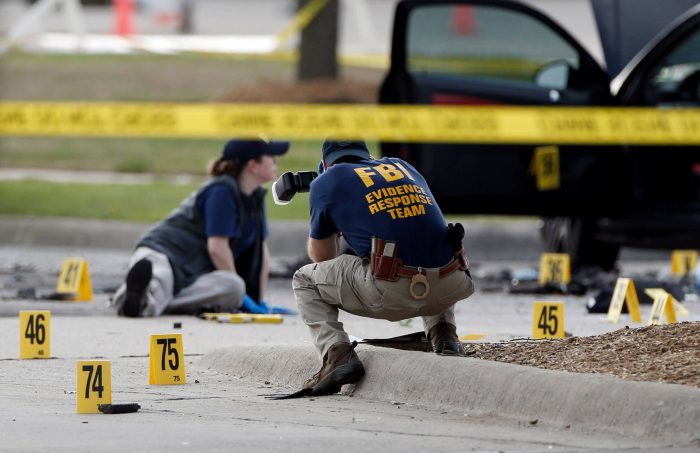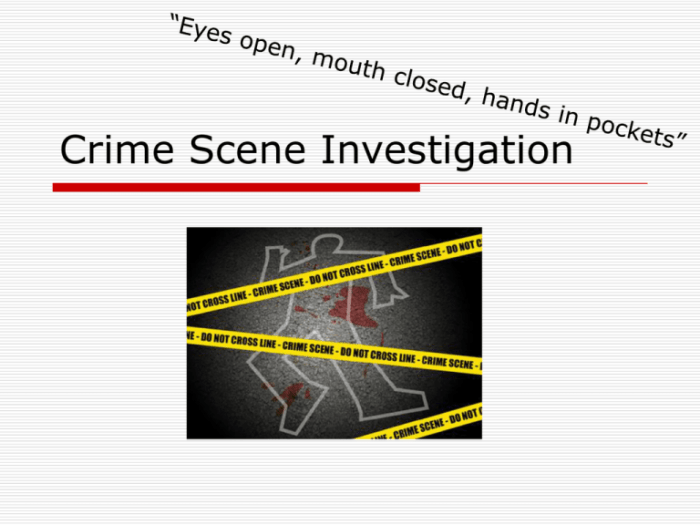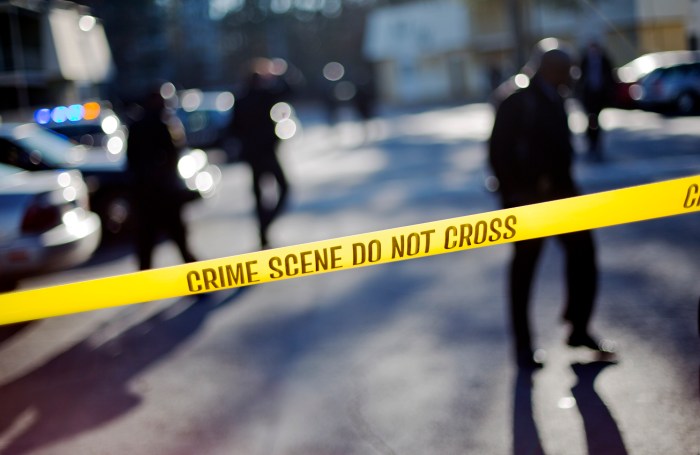The 7s of crime scene investigation provide a comprehensive framework for effectively processing crime scenes, ensuring the collection and preservation of crucial evidence. This guide delves into each step, from securing and preserving the scene to reconstructing the events that transpired.
By understanding and applying the 7s, investigators can enhance the accuracy and reliability of their findings, contributing to successful case outcomes.
Scene Security and Preservation
Securing and preserving a crime scene is crucial to maintain its integrity and prevent contamination or alteration of evidence. Establishing and maintaining scene security involves implementing measures to protect the scene from unauthorized access, damage, or interference.
Methods and Procedures
- Establish a Perimeter:Create a physical barrier around the scene to restrict access to authorized personnel only.
- Control Entry and Exit:Designate specific entry and exit points and monitor the movement of individuals entering or leaving the scene.
- Document the Scene:Take detailed photographs, sketches, and notes to record the initial condition of the scene before any alterations occur.
- Preserve Physical Evidence:Collect and secure physical evidence, such as fingerprints, DNA, and trace evidence, using proper techniques to prevent contamination or loss.
- Minimize Contamination:Wear protective gear and take precautions to prevent the introduction of foreign materials or DNA into the scene.
Role of Law Enforcement
Law enforcement officers play a vital role in protecting the integrity of the crime scene by:
- Enforcing the perimeter and controlling access to the scene.
- Coordinating with investigators and forensic personnel to ensure proper evidence collection and preservation.
- Documenting the scene and maintaining a chain of custody for evidence.
- Protecting the rights of individuals involved in the investigation while preserving the integrity of the evidence.
Scene Assessment

Scene assessment is a critical step in crime scene investigation, as it provides the foundation for all subsequent investigative actions. It involves a thorough examination of the scene to identify, document, and collect physical evidence, as well as to determine the sequence of events that transpired.
The assessment process typically begins with a walk-through of the scene to gain an overall understanding of its layout and any potential hazards. This is followed by a more detailed examination of specific areas, such as the point of entry, the victim’s location, and any areas where evidence may be present.
Types of Evidence
A wide range of evidence may be present at a crime scene, including:
- Physical evidence: This includes any tangible objects that can be collected and analyzed, such as weapons, fingerprints, DNA, and trace evidence.
- Biological evidence: This includes any biological materials, such as blood, saliva, hair, and bodily fluids, that can be used to identify individuals or determine their involvement in a crime.
- Digital evidence: This includes any electronic devices or data that can be used to store or transmit information, such as computers, cell phones, and surveillance cameras.
- Environmental evidence: This includes any evidence that relates to the physical environment of the crime scene, such as weather conditions, lighting, and the presence of insects or animals.
Identifying and Documenting Physical Evidence
Physical evidence is often the most important type of evidence at a crime scene. It can provide valuable information about the crime, the victim, and the suspect. To ensure that physical evidence is properly identified and documented, investigators must follow a systematic approach that includes:
- Searching for and locating evidence
- Preserving and protecting evidence
- Documenting evidence
- Collecting evidence
By following these steps, investigators can ensure that physical evidence is properly preserved and documented, and that it can be used effectively in the investigation and prosecution of the crime.
Sketching and Photography
Sketching and photography are crucial components of crime scene investigation, providing a permanent record of the scene and its contents.
Sketchingallows investigators to create a detailed, scaled drawing of the scene, capturing the layout, dimensions, and locations of key evidence. Photographysupplements sketches by providing a visual record of the scene, capturing colors, textures, and other details that may not be easily conveyed in a sketch.
Techniques for Accurate Sketching
- Use a measuring tape and ruler to ensure accuracy.
- Draw to scale, using a consistent unit of measurement throughout.
- Include all relevant details, such as furniture, windows, doors, and any other objects or evidence.
- Label all objects and indicate their measurements and distances from fixed points.
Techniques for Detailed Photography
- Use a high-resolution camera with a wide-angle lens.
- Take multiple photographs from different angles and distances.
- Use natural lighting whenever possible, but supplement with artificial lighting if necessary.
- Use a tripod to ensure stability and prevent camera shake.
Note-Taking and Report Writing

Thorough and accurate note-taking at a crime scene is crucial for preserving valuable information and providing a solid foundation for subsequent investigations and legal proceedings. Effective note-taking ensures that all relevant observations, measurements, and details are meticulously recorded, minimizing the risk of memory lapses or omissions.
Note-Taking Practices, The 7s of crime scene investigation
To ensure effective note-taking at a crime scene, several best practices should be followed:
- Be objective and unbiased:Notes should accurately reflect what is observed without personal interpretations or assumptions.
- Use a structured approach:Employ a consistent format for recording observations, such as using a standardized form or template.
- Include all relevant details:Record not only what is seen but also what is heard, smelled, or felt.
- Be specific and descriptive:Avoid vague or general terms; provide precise descriptions using measurements, colors, and other specific details.
- Draw diagrams and sketches:Visual representations can supplement written notes and provide a clear understanding of the scene layout.
- Use abbreviations and symbols:Utilize standardized abbreviations and symbols to save time and ensure clarity.
Crime Scene Report Structure and Content
A comprehensive crime scene report typically includes the following sections:
- Introduction:Provides an overview of the case, including the date, time, and location of the incident.
- Scene Description:Describes the overall scene, including its size, layout, and any relevant environmental conditions.
- Evidence Documentation:Lists and describes all physical evidence collected, including photographs, sketches, and any other relevant documentation.
- Witness Statements:Summarizes the statements of any witnesses who were present at the scene.
- Investigative Findings:Presents the investigator’s analysis of the evidence and any conclusions drawn.
- Recommendations:Provides suggestions for further investigation or action.
Evidence Collection and Preservation

Evidence collection and preservation are crucial steps in crime scene investigation as they ensure the integrity and reliability of evidence for use in legal proceedings. The primary principles of evidence collection and preservation include minimizing contamination, preserving the original condition of evidence, and maintaining a proper chain of custody.
Various methods are employed for collecting and packaging different types of evidence, such as physical evidence (e.g., fingerprints, bloodstains), biological evidence (e.g., DNA, bodily fluids), and digital evidence (e.g., electronic devices, social media accounts). Each type of evidence requires specific handling and packaging techniques to prevent contamination and preserve its integrity.
Chain of Custody
Maintaining the chain of custody is paramount in ensuring the integrity and admissibility of evidence in court. The chain of custody documents the individuals who handled the evidence, the dates and times of transfer, and any changes made to the evidence.
This documentation helps prevent tampering and ensures that the evidence presented in court is the same as what was collected at the crime scene.
Interviewing Witnesses and Suspects

Interviewing witnesses and suspects at a crime scene is a crucial aspect of crime scene investigation. Effective interviews can yield valuable information that aids in reconstructing the events, identifying suspects, and building a strong case for prosecution.
Techniques for Interviewing Witnesses and Suspects
There are several techniques that can be employed to effectively interview witnesses and suspects at a crime scene:
- Active Listening:Listen attentively to the witness’s or suspect’s account, paying attention to both verbal and non-verbal cues. Ask clarifying questions to ensure understanding.
- Empathy and Rapport:Establish a rapport with the witness or suspect by showing empathy and understanding. This can help them feel more comfortable and willing to share information.
- Non-Leading Questions:Ask open-ended, non-leading questions that allow the witness or suspect to provide their own account of events.
- Memory Jogging:Use prompts, such as photographs or diagrams, to help the witness or suspect recall details.
- Documentation:Document the interview thoroughly, including the witness’s or suspect’s statements, demeanor, and any other relevant observations.
Step-by-Step Guide to Conducting Effective Interviews
Follow these steps to conduct effective interviews at a crime scene:
- Establish rapport:Introduce yourself and explain the purpose of the interview. Show empathy and understanding.
- Gather basic information:Obtain the witness’s or suspect’s name, contact information, and relationship to the crime.
- Ask open-ended questions:Allow the witness or suspect to provide their own account of events without interruption.
- Use memory jogging techniques:Use photographs, diagrams, or other prompts to help the witness or suspect recall details.
- Clarify and probe:Ask clarifying questions to ensure understanding and to elicit more information.
- Document the interview:Write down the witness’s or suspect’s statements, demeanor, and any other relevant observations.
- Time-Sequence Analysis:The sequence of events is established by analyzing the physical evidence and witness statements.
- Bloodstain Pattern Analysis:The patterns of bloodstains provide valuable information about the victim’s movements, the type of weapon used, and the direction of force.
- Ballistics Analysis:The trajectory of bullets and other projectiles is reconstructed to determine the location of the shooter and the victim.
- Forensic Engineering:Engineering principles are applied to analyze structural damage, vehicle accidents, and other complex events.
- Forensic Scientists:Analyze physical evidence, such as DNA, fingerprints, and trace materials.
- Medical Examiners:Determine the cause and manner of death, as well as the time of death.
- Engineers:Analyze structural damage, vehicle accidents, and other complex events.
- Psychologists:Provide insights into the behavior and motivations of the individuals involved.
Importance of Building Rapport and Obtaining Accurate Information
Building rapport with the witness or suspect is crucial for obtaining accurate information. When the witness or suspect feels comfortable and respected, they are more likely to provide truthful and detailed information.
Accurate information is essential for reconstructing the events of the crime, identifying suspects, and building a strong case for prosecution. By employing effective interviewing techniques, investigators can increase the likelihood of obtaining accurate and reliable information from witnesses and suspects at a crime scene.
Crime Scene Reconstruction

Crime scene reconstruction involves recreating the sequence of events that transpired at a crime scene. Its purpose is to provide a comprehensive understanding of the incident, identify potential suspects, and support legal proceedings.The process of crime scene reconstruction begins with a thorough examination of the scene, including the collection of physical evidence, documentation of the scene, and interviews with witnesses.
Experts in various fields, such as forensic scientists, engineers, and medical professionals, are often consulted to provide specialized insights.
Methods of Crime Scene Reconstruction
Several methods are employed to reconstruct crime scenes:
Role of Experts in Crime Scene Reconstruction
Experts play a crucial role in crime scene reconstruction. They provide specialized knowledge and expertise in their respective fields:
Crime scene reconstruction is a complex and specialized field that requires a multidisciplinary approach. By combining the expertise of various experts and employing scientific methods, investigators can reconstruct crime scenes with accuracy and precision, providing valuable insights for investigations and legal proceedings.
FAQs: The 7s Of Crime Scene Investigation
What is the primary objective of scene security and preservation?
To prevent contamination, alteration, or destruction of evidence and to maintain the integrity of the scene for investigation.
What is the purpose of sketching and photographing the crime scene?
To create a permanent and accurate record of the scene, including the location and condition of evidence.
What is the significance of taking detailed notes at the crime scene?
To document observations, impressions, and any other relevant information that may not be captured through other means.
What is the importance of maintaining the chain of custody for evidence?
To ensure the integrity and authenticity of evidence throughout its handling and storage, preventing any tampering or contamination.